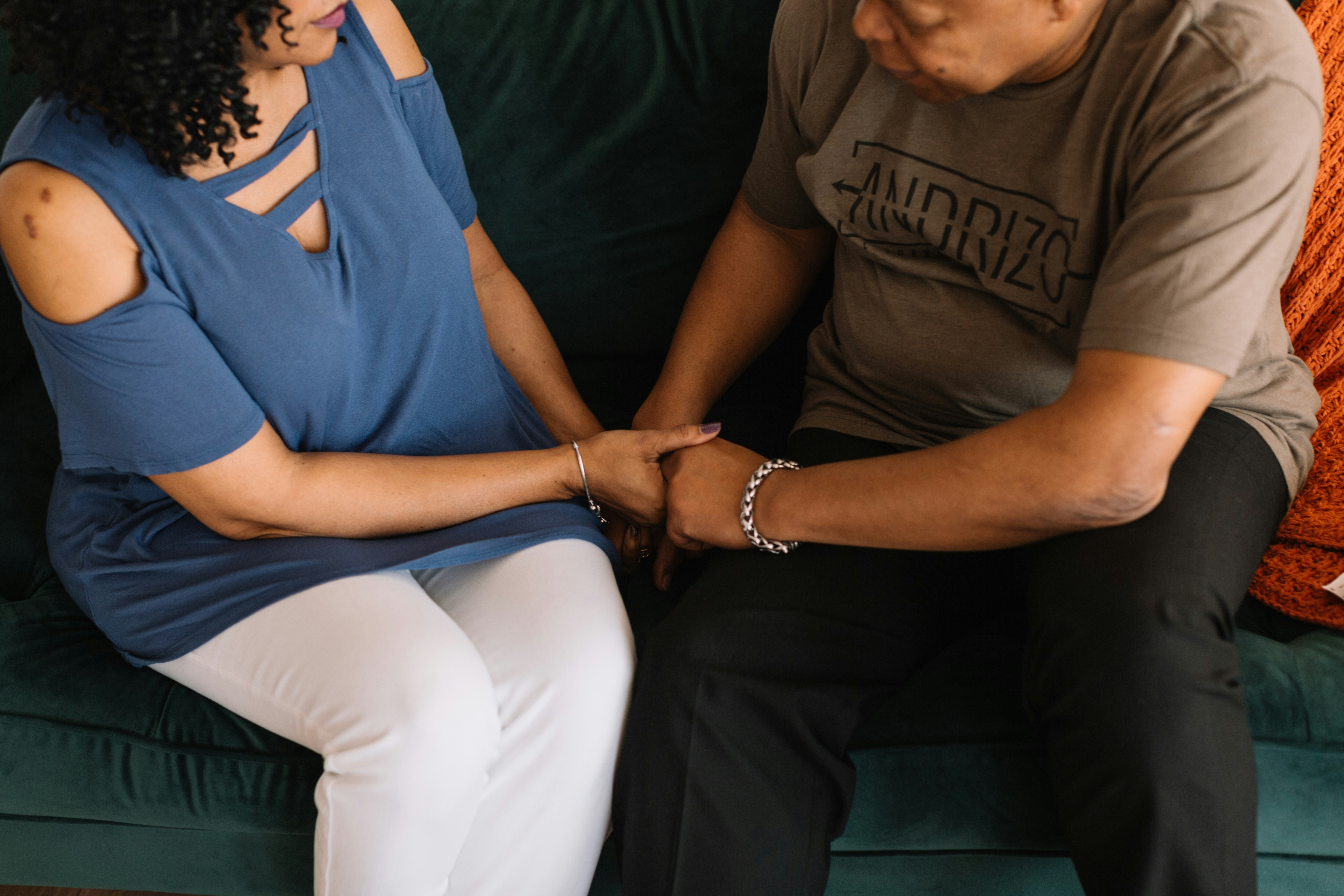There are many reasons couples can stop connecting sexually. These can include a fear of rejection, a high degree of conflict, past hurts, avoidance, and exhaustion. Sometimes it’s not that easy to just flip a switch and act sexy again in a committed relationship. So, how do you restart intimacy in your sex life? Sensate focus can help.
What Is Sensate Focus?
Oftentimes, “sex” can be used to describe goal-oriented behavior focusing only on the genitals, penetration, and orgasm. “Sensate” is a fancy word that means “sensation”; the idea is to focus primarily on sensory perceptions, or how touch feels in the moment.
Sensate focus is a tool originally developed by sex therapists Masters and Johnson in 1970. The method is designed to shift the focus away from formulaic expectations and toward an intensive focus on sensations, such as pressure and temperature. The goal is for each partner to identify what feels good, what they like and don’t like, without the end goal of orgasm. In other words, this exercise is all about the journey, not the destination. For couples who want to reignite their physical intimacy, this can be a useful way to ease back into it.
How Does Sensate Focus Work?
Sensate focus is a structured approach to sex therapy. The technique is designed to address barriers to intimacy such as miscommunication issues, performance demand anxiety and insecurity, sexual skill gaps, past hurts of rejection and resentment, body image issues, erectile dysfunction, and lack of sexual arousal. It is also useful for those who may not be aware of their own body’s likes and dislikes, or who are not entirely comfortable with sex and intimacy to begin with.
There are five steps to sensate focus:
- Non-sexual touching (no erogenous zones)
- Touching erogenous zones (genitals and breasts)
- Added Lubrication (to enhance sensation)
- Mutual Touching
- Sensual Intercourse
The Setup: Be Sensual, Not Sexual
Although it may not feel romantic or spontaneous, time for the sensate focus exercise is scheduled. This allows both partners to anticipate and settle in to the idea of restoring intimacy. The environment should be comfortable and free of distractions, and 30-45 minutes is set aside for each session.
The first few sessions are structured in such a way that sex is off limits. This allows both partners to focus on sensations, and it eliminates any fears or anxieties around penetration or performance. This also allows space for the creation of new sexual behaviors, so that there is not a default to old habits of intimacy.
Step 1: Non-Genital Touching
To begin, both partners are clean and undressed, with minimal jewelry. One will be the “toucher” and the other will be the “receiver” for 15 minutes, switching roles for a total of 30 minutes. The receiving partner should focus solely on their own sensations and experience while being touched. The receiving partner is not to reciprocate with touching; instead, notice how the touch feels without evaluating it. It’s ok to be selfish here; feeling awkward or forced is normal when first attempting this technique. Feel free to communicate if any discomfort arises to the touching partner.
Here are some things to focus on:
- Try to notice the texture of your partner’s skin in different areas of their body. Bring those feelings into your active awareness.
- Try to vary the firmness and tempo of touch. Notice if the tempo change alters any perceptions.
- Try touching with your whole hand, as well as just your fingertips. Notice how touching with two hands feels.
- The goal is not to massage, nor is it to touch your partner in such a way that you think will make them happy or “turned on.”
Reverse roles after 15 minutes, and try not to take a break in between. Step 1 may occur four to six times over a two-month period. However, the decision to proceed to Step 2 is flexible, and no test or threshold is required to pass before Step 2 can be completed.
Step 2: Genital and Breast Touching
Start with the same setup as Step 1. The toucher continues the exploration of the receiver’s body, but remember the point is not to try to be turned on or turn the other person on. Each partner pays attention to their own sensual and tactile sensory experiences. Slow things down. Feel your partner’s back, their hair, and how the texture of their skin changes from one contour of their body to another. Feel the rhythm of the moment and how comfortable you are in it.
Next, nonverbal communication is added: the “receiver” puts a hand onto the “toucher’s” hand and directs their touch. This hand-guiding technique provides a simple yet effective way to offer feedback on subtle differences in preferences. In this way, the receiver can indicate to their partner where they prefer a firmer touch, a lingering one, a slower touch, or when to transition from one part of the body to another. Keep in mind that a signal to their hand is not a rejection or criticism, just an offer to try alternatives.
Signals are important so that the toucher isn’t just guessing at what the receiver’s preferences are. Signal to each other when you are ready to switch roles; there is no specific time requirement or limitation. Both partners need to experience their turn and complete Step 2 before boredom or tiredness sets in.
Here are some tips to focus on:
- One comfortable position to try is sitting in a big spoon (toucher) and little spoon (receiver) configuration.
- Kissing, sex, and excessive genital touching are not included in this step of exploration. (Kissing tends to lead to the emergence of old automatic patterns, which we are trying to break.)
- It is okay for orgasm to occur, but this is not the goal.
- If either partner feels a sense of obligation or discomfort, it’s advisable to stop.
Step 3: Add Lubrication
Adding lubrication or lotion alters the sensory experience of touch. Warm up the fluid in your hands before application. Feel free to use lubrication to start, or introduce halfway through. Maybe keep one hand slick and the other dry. Remember, the point is not to massage; it is to focus on the sensation.
Step 4: Mutual Touching
No more taking turns; now both partners get to experience touching and being touched. Remember that the idea is to stay focused on sensations, not to be sexual, so it’s okay to refrain from kissing and intercourse in this step. Oral stimulation is invited in this step, which is different from oral sex. Use lips and tongue to increase the sensation focus. Consider changing the context from the routine (bed), to something new (shower, sofa, or another setting).
Step 5: Sensual Intercourse
Using all the steps and awareness learned in the previous steps, now genital contact is introduced. The goal is to discover what feels good and is pleasurable, not to “have sex.” Continuing an encounter from steps 1-4, get into a position where penetration is possible. Going slowly, start with genital to genital touching, rubbing, and, if desired, partial penetration. Try and explore different forms of sensual variation, such as pausing for a few seconds or exiting penetration and resuming after 10-20 seconds.
Quicker, shallower thrusting is preferred by many couples when attempting penetration. Try to focus on sensations and give each other the opportunity to enjoy this new way of having intercourse. Going forward, let your partner know in advance what you’re desiring. Through the process of sensate focus, both partners have gained an awareness and understanding of both their own and their partner’s preferences. Communication is key to a healthy sensuality and sexuality.
Finally, after having regular, scheduled time for sensual connection, partners are encouraged to keep the new information they have learned about each other in mind. Hopefully, both have gained a deeper understanding of the other’s preferences and desires. While the structured nature of the exercise ends, one part may be kept: keep sex on the schedule!
Ray Myers, MA, LMFT-A, is a therapist in our Plano office, offering both in-person and virtual sessions for individuals, couples, and families. Call to schedule a session with Ray today!



